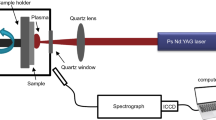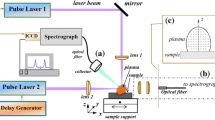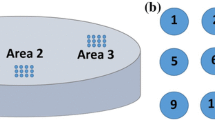Abstract
Stainless steel is a notably beneficial product and is widely used in many applications. Controlling the quality of steel products by determining their trace elemental content is essential. The content of trace elements such as Cr in steel protects the alloy from corrosion and enhances its lifetime, especially in the case of steel embedded in concrete structures. This article presents a quantitative analysis of the trace element Cr in steel samples using advanced laser-induced breakdown spectroscopy (LIBS) with an Nd:YAG laser at wavelengths of 355 and 1064 nm. The LIBS emission intensity of Cr at a laser wavelength of 355 nm was improved compared to that at 1064 nm. Notably, the calibration curves exhibit a zero intercept using the LIBS technique at the third harmonic (355 nm) and fundamental (1064 nm) wavelengths generated by the Nd:YAG laser. The detection limits for Cr in steel were determined as 21 and 36 parts per million using the laser wavelengths of 355 and 1064 nm, respectively. This study demonstrated that the wavelength of 355 nm is significantly more suitable for the quantitative analysis of stainless steel than 1064 nm in laser-induced spectroscopy.








Similar content being viewed by others
Availability of Data and Materials
All data generated or analyzed during this study are included in this published article.
References
Wang, F.-C.; Han, L.-H.: Analytical behavior of carbon steel-concrete-stainless steel double-skin tube (DST) used in submarine pipeline structure. Mar. Struct. 63, 99–116 (2019). https://doi.org/10.1016/j.marstruc.2018.09.001
Chai, G.; Bergström, J.; Burman, C.: Crack initiation in bulk matrix of austenitic stainless steel during very high cycle fatigue. Mater. Perform. Charact. 12, 20220094 (2023). https://doi.org/10.1520/mpc20220094
Voloskov, B.; Evlashin, S.; Dagesyan, S.; Abaimov, S.; Akhatov, I.; Sergeichev, I.: Very high cycle fatigue behavior of additively manufactured 316L stainless steel. Materials. 13, 3293 (2020). https://doi.org/10.3390/ma13153293
Li, Z.; Guo, J.; Li, W.; Zhao, Y.; Gong, J.: Experimental study on mechanical properties of corroded steel used as containment liner in nuclear power plant. J. Nucl. Sci. Technol. 59, 1266–1284 (2022). https://doi.org/10.1080/00223131.2022.2044404
Analysis of cracking of ferroite stainless steel welded pipe for automobile exhaust system, foreign language science and technology. J. Database Eng. Technol. (2022). https://doi.org/10.47939/et.v3i5(07).12.
Dubina, D.; Dinu, F.; Stratan, A.: High-strength steel and dissipative fuse solutions for seismic-resistant building structures, Steel. Construction 13, 154–164 (2020). https://doi.org/10.1002/stco.202000028
Kuropyatnik, I.N.: Long-term stability of measurements of the elemental composition of steel using a vacuum atomic emission spectrometer «Grand-Expert», Industrial Laboratory. Diagnostics Mater. 85, 135–138 (2019). https://doi.org/10.26896/1028-6861-2019-85-1-ii-135-138
Sanyal, K.; Dhara, S.: Direct non-destructive trace and major elemental analysis in steel samples utilizing micro-focused bremsstrahlung radiation in X-ray fluorescence geometry. Anal. Sci. 38, 665–673 (2022). https://doi.org/10.1007/s44211-022-00082-x
Franciscono, A.; Rollet, S.: Silicon determination in stainless steels via inductively coupled plasma optical emission spectrometry: An overview based on experimental data. Steel Res. Int. 92, 2000537 (2021). https://doi.org/10.1002/srin.202000537
Li, P.; Cai, W.; Shao, X.: Improved inductively coupled plasma optical emission spectroscopy analysis of trace elements in complex matrices by chemometric resolution. J. Anal. Atomic Spectrom. 30, 936–940 (2015). https://doi.org/10.1039/c5ja00031a
Meor, Y.M.S.; Masliana, M.; Wilfred, P.: Quantitative energy dispersive X-Ray flourescence analysis of low alloy steel by regression and modified fundamental parameter techniques. Advanced Materials Research. 620, 480–485 (2012). https://doi.org/10.4028/www.scientific.net/amr.620.480
Miyazaki, T.; Sasaki, T.: X-Ray Residual stress measurement of austenitic stainless steel based on fourier analysis. Nuclear Technol. 194, 111–116 (2016). https://doi.org/10.13182/nt15-25
Szymczycha-Madeja, A.; Welna, M.; Pohl, P.: Simple and fast sample preparation procedure prior to multi-element analysis of slim teas by ICP OES. Food Anal. Methods 7, 2051–2063 (2014). https://doi.org/10.1007/s12161-014-9850-6
You, Z.; Li, X.; Huang, J.; Chen, R.; Peng, J.; Kong, W.; Liu, F.: Agarose film-based liquid-solid conversion for heavy metal detection of water samples by laser-induced breakdown spectroscopy. Molecules 28, 2777 (2023). https://doi.org/10.3390/molecules28062777
Niu, S.; Zheng, L.; Zeng, H.: Laser sintered adsorption of metal elements on oxide nanoparticles for laser induced breakdown spectroscopic analysis of solid. Spectrochim. Acta, Part B 158, 105626 (2019). https://doi.org/10.1016/j.sab.2019.05.015
Khumaeni, A.; Budi, W.S.; Kurniawan, K.H.; Kurihara, K.: Metal powder-assisted laser induced breakdown spectroscopy (LIBS) using pulse CO2 laser for liquid analysis. J. King Saud Univ. Sci. 34, 101901 (2022). https://doi.org/10.1016/j.jksus.2022.101901
Sturm, V.; Erben, B.; Fleige, R.; Wirz, W.: Carbon analysis of steel using compact spectrometer and passively Q-switched laser for laser-induced breakdown spectroscopy. Opt. Express 27, 36855 (2019). https://doi.org/10.1364/oe.27.036855
Khumaeni, A.; Budi, W.S.; Kurihara, K.; Kurniawan, H.; Kagawa, K.: Trace metal analysis of element on material surface using pulse CO2 laser-induced breakdown spectroscopy applying vaporization technique. Heliyon. 6, e04670 (2020). https://doi.org/10.1016/j.heliyon.2020.e04670
Aparna, N.; Vasa, N.J.; Sarathi, R.: Analysis of copper contamination in transformer insulating material with nanosecond- and femtosecond-laser-induced breakdown spectroscopy. J. Phys. D Appl. Phys. 51, 235601 (2018). https://doi.org/10.1088/1361-6463/aac15c
Dong, F.-Z.; Chen, X.-L.; Wang, Q.; Sun, L.-X.; Yu, H.-B.; Liang, Y.-X.; Wang, J.-G.; Ni, Z.-B.; Du, Z.-H.; Ma, Y.-W.; Lu, J.-D.: Recent progress on the application of LIBS for metallurgical online analysis in China, Frontiers of. Physics 7, 679–689 (2012). https://doi.org/10.1007/s11467-012-0263-y
Ctvrtnickova, T.; Mateo, M.P.; Yañez, A.; Nicolas, G.: Application of LIBS and TMA for the determination of combustion predictive indices of coals and coal blends. Appl. Surf. Sci. 257, 5447–5451 (2011). https://doi.org/10.1016/j.apsusc.2010.12.025
Sezer, B.; Bilge, G.; Boyaci, I.H.: Capabilities and limitations of LIBS in food analysis. TrAC, Trends Anal. Chem. 97, 345–353 (2017). https://doi.org/10.1016/j.trac.2017.10.003
Keerthi, K.; George, S.D.; Kulkarni, S.D.; Chidangil, S.; Unnikrishnan, V.K.: Elemental analysis of liquid samples by laser induced breakdown spectroscopy (LIBS): Challenges and potential experimental strategies. Opt. Laser Technol. 147, 107622 (2022). https://doi.org/10.1016/j.optlastec.2021.107622
Kaiser, J.; Novotný, K.; Martin, M.Z.; Hrdlička, A.; Malina, R.; Hartl, M.; Adam, V.; Kizek, R.: Trace elemental analysis by laser-induced breakdown spectroscopy—Biological applications. Surf. Sci. Rep. 67, 233–243 (2012). https://doi.org/10.1016/j.surfrep.2012.09.001
Khan, Z.H.; Ullah, M.H.; Rahman, B.; Talukder, A.I.; Wahadoszamen, Md.; Abedin, K.M.; Haider, A.F.M.Y.: Laser-Induced Breakdown Spectroscopy (LIBS) for Trace Element Detection: A Review. J. Spectrosc. 2022, 1–25 (2022). https://doi.org/10.1155/2022/3887038
Afgan, M.S.; Hou, Z.; Wang, Z.: Quantitative analysis of common elements in steel using a handheld μ-LIBS instrument. J. Anal. At. Spectrom. 32, 1905–1915 (2017). https://doi.org/10.1039/c7ja00219j
Pandhija, S.; Rai, N.K.; Rai, A.K.; Thakur, S.N.: Contaminant concentration in environmental samples using LIBS and CF-LIBS. Appl. Phys. B 98, 231–241 (2009). https://doi.org/10.1007/s00340-009-3763-x
Marpaung, A.M.; Harefa, E.; Pardede, M.; Karnadi, I.; Hedwig, R.; Tanra, I.; Suliyanti, M.M.; Lie, Z.S.; Shiddiq, M.; Ramli, M.; Lahna, K.; Jobiliong, E.; Abdulmadjid, S.N.; Idris, N.; Khumaeni, A.; Setiabudi, W.; Suyanto, H.; Lie, T.J.; Kurniawan, K.H.; Kagawa, K.: Simple defocus laser irradiation to suppress self-absorption in laser-induced breakdown spectroscopy (LIBS). Heliyon. 8, e10057 (2022). https://doi.org/10.1016/j.heliyon.2022.e10057
Jiang, X.; Hayden, P.; Costello, J.T.; Kennedy, E.T.: Double-pulse laser induced breakdown spectroscopy with ambient gas in the vacuum ultraviolet: Optimization of parameters for detection of carbon and sulfur in steel. Spectrochim. Acta, Part B 101, 106–113 (2014). https://doi.org/10.1016/j.sab.2014.07.002
Gaudiuso, R.; Dell’Aglio, M.; De Pascale, O.; Santagata, A.; De Giacomo, A.: Laser-induced plasma analysis of copper alloys based on Local Thermodynamic Equilibrium: An alternative approach to plasma temperature determination and archeometric applications. Spectrochim. Acta, Part B 74–75, 38–45 (2012). https://doi.org/10.1016/j.sab.2012.06.034
Khumaeni, A.; Motonobu, T.; Katsuaki, A.; Masabumi, M.; Ikuo, W.: Enhancement of LIBS emission using antenna-coupled microwave. Opt. Express 21, 29755 (2013). https://doi.org/10.1364/oe.21.029755
Khumaeni, A.; Budi, W.S.; Hedwig, R.; Kurniawan, K.H.: Quantification of the trace metal element cr in stainless steel using picosecond laser-induced breakdown spectroscopy at atmospheric pressure. Arab. J. Sci. Eng. 48, 8165–8172 (2023). https://doi.org/10.1007/s13369-023-07675-2
Acknowledgements
The current study received financial assistance from the Institute for Research and Community Services at Diponegoro University under the Research Grant of RPIBT 2023 No. 225-43/UN7.D2/PP/IV/2023. Dr. Gondal is thankful to KFUPM for the support.
Author information
Authors and Affiliations
Contributions
AK: Conceptualization, Methodology, Finalization of manuscript. WSB: Conceptualization, Analyses of experimental results. RH: Experiment, methodology. KHK: Conceptualization, Finalization of manuscript. MT: Data analysis, Writing- Reviewing and Editing. Dr G: supervision, writing, reviewing and editing of manuscript.
Corresponding author
Ethics declarations
Conflict of interest
The authors declare that they have no known competing financial interests or personal relationships that could have appeared to influence the work reported in this paper.
Ethical Approval
This study did not involve human participants or biological materials and therefore no ethical approval is required.
Rights and permissions
Springer Nature or its licensor (e.g. a society or other partner) holds exclusive rights to this article under a publishing agreement with the author(s) or other rightsholder(s); author self-archiving of the accepted manuscript version of this article is solely governed by the terms of such publishing agreement and applicable law.
About this article
Cite this article
Khumaeni, A., Budi, W.S., Hedwig, R. et al. Spectrochemical Analysis of Stainless Steel Using 355 nm and 1064 nm Nd:YAG Laser-induced Breakdown Spectroscopy. Arab J Sci Eng (2024). https://doi.org/10.1007/s13369-024-09015-4
Received:
Accepted:
Published:
DOI: https://doi.org/10.1007/s13369-024-09015-4




